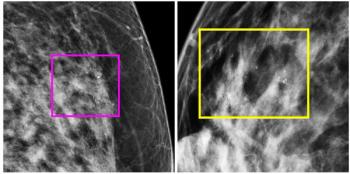
Report questions performance of installed CR mammography units
A new U.K. report has highlighted uncertainties surrounding the use of computed radiography for breast screening. The findings add fuel to ongoing debates in Europe about the performance of CR mammography in clinical practice.
A new U.K. report has highlighted uncertainties surrounding the use of computed radiography for breast screening. The findings add fuel to ongoing debates in Europe about the performance of CR mammography in clinical practice.
The latest concerns came from the U.K.'s nationwide breast screening program (NHSBSP), a government-funded effort that offers a free mammography exam every three years to women aged 50 to 64. The service is being expanded to cover women up to age 70.
NHSBSP investigators tested six CR mammography units in place at U.K. hospitals. The lineup of hardware, all supplied by Fuji Photo, comprised two FCR5000 systems, two FCR5000MA systems, and two Profect systems. The FCR5000MA and Profect systems both produce images with 50-µm-sized pixels, while the older FCR5000 has a resolution of 100 µm.
The NHSBSP found that while the two newer systems could, in theory, meet European minimum quality assurance targets, they did not always do so in practice. None of the three CR systems met the expected technical performance of either screen-film or digital radiography technology. The report concluded that Fuji's two 50-µm systems should be preferred over its 100-µm system for screening purposes. It further noted, however, that a proper assessment of any CR system should take account of clinical trial data as well as technical evaluations.
The NHSBSP report highlights the difficulties in attempting to correlate technical measurements of image quality with clinical assessments, said Leo Maguire, technical manager for Fuji's x-ray systems business in the U.K.
"The use of CR in breast screening is relatively new, and inevitably comparisons are done with the existing screen-film combinations," Maguire said. "Because of the nature of CR images, physical comparisons do not always give a true picture of the image quality."
The failure of Fuji's 50-µm systems to consistently meet QA targets also reflects the importance of setup and reporting practices, Maguire said. None of the systems tested had been fully optimized, yet radiologists have no guidelines to follow when adjusting the "look" of their images.
"Work is going on to look at x-ray dose and other factors," he said. "This work will make it easier to arrive at a 'universal' optimized setup."
The choice of soft-copy monitor can also affect image quality. Fuji recommends that mammography reporting be carried out on 5-megapixel monitors that are recalibrated at appropriate intervals.
CR technology is being marketed in the U.K. and selected countries other than the U.S. as a cost-effective and flexible alternative to fully digital mammography. The validity of the technology as a replacement for screen-film mammography has been of growing interest.
The NHSBSP decided to review the performance of CR systems operating within its screening service after its staff were notified of potential problems with the quality of images produced by the Agfa Embrace CR(1A) system. These worries stemmed from a customer complaint filed in France in December 2003 over the performance of Agfa's CR system in visualizing subtle microcalcifications (DI SCAN 10/13/04).
At the time of the review, the NHSBSP was not using any Agfa CR systems for its mammography screening work. This is not surprising, given that neither the Embrace CR(1A) nor its upgraded successor, the Embrace CR(1B), has ever been marketed for screening. Nonetheless, the performance of CR mammography technology had become an important issue in the U.K., given the progressive digitization of radiology departments in England under a centralized PACS procurement process (DI SCAN 04/04/05).
Questions have been raised, however, about NHSBSP's choice of systems to assess. Maguire expressed surprise at the inclusion of 100-µm systems in the NHSBSP study, noting that the FCR5000 was not intended for breast screening.
The distinction between fit-for-screening CR mammography systems versus those recommended for diagnostic mammography is an important one, according to Iskander Accaoui, Agfa's digital radiography global marketing manager. Many sites in Europe are now using an Agfa CR solution for mammography, but only on patients with signs or symptoms of breast disease.
"The scope of the Agfa CR Embrace system is currently restricted to diagnostic mammography, where it has been clinically proven to be equivalent to conventional film," he said. "For screening mammography, Agfa offers DR-based systems, which are clinically proven to be equivalent to conventional film for this specific intended use."
Kodak's worldwide installed based of CR mammography units includes a few sites operating screening services, although the majority are not used for this purpose, according to Susanne Schmitz, product manager for Kodak's high-tier CR portfolio.
"Whenever we sell a system, we make sure it meets local regulations. That is, for us, the threshold," Schmitz said.
To date, Kodak's mammography option for its DirectView CR 850 and CR 950 has provided 100-µm pixel scanning. An enhanced digital mammography option, offering 50-µm resolution, will be available in June to new and existing customers in Europe, greater Asia, Japan, and Latin America. Regulatory approval for use of this system in the U.S. and Canada is still pending.
Newsletter
Stay at the forefront of radiology with the Diagnostic Imaging newsletter, delivering the latest news, clinical insights, and imaging advancements for today’s radiologists.




























